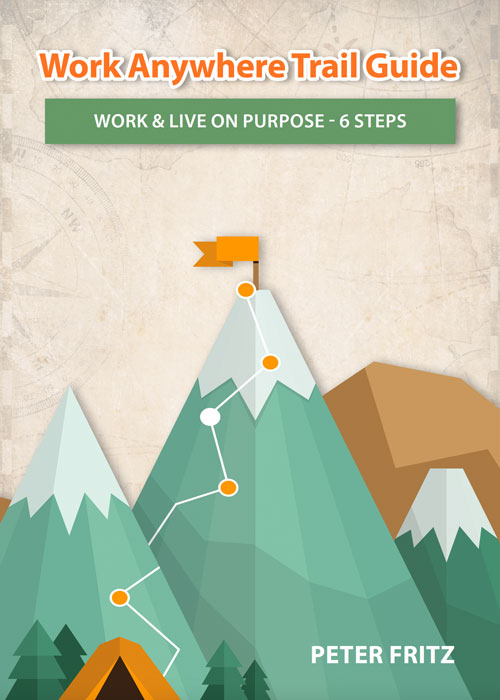[smart_track_player url=”http://traffic.libsyn.com/midlifetribe/6_Steps_to_Working_and_Living_on_Your_Terms_-_073.mp3″ background=”#f2f2f2″ social_gplus=”false” social_linkedin=”true” social_email=”true” ]
Regardless of what we tell ourselves, we each want the same things. We want a reason to drag our arse out of bed each day, the power to say ‘no’ to things we don’t like and enough time to enjoy life with those we love.
But somewhere along the way, we dilute (or surrender entirely) these things for superficial aims – our career, a job title, and material possessions. We convince ourselves we can present the illusion of purpose, control and the ‘good life’, and no one will question it. After all, we’re all doing it, so to highlight it in others would be to concede it in ourselves.
Following my ‘life reset’ a decade ago (financial collapse, divorce, depression, recovery), I realised I already had what I needed to live a very good life. I just had to tweak a few things. Mostly, I had to keep asking the question, “Why am I doing this? What’s the outcome I’m looking for?”
Once I knew what I valued – truly valued – the rest became clear. For example, my highest values today are freedom, purpose and happiness. If something (a project, commitment, habit, or relationship) brings me closer to freedom or purpose or happiness, it’s worth my limited time. If it doesn’t, it isn’t. Simple, right? And simple is good.
After 35 years of working, striving, failing and succeeding, I know now that freedom precedes everything. Not absolute freedom – but structured freedom. I’ve learned that through a deliberate, structured approach to scaling our individual mountains, we really can have it all. We can be of service but do it autonomously; be productive without being stressed; explore new horizons without betting the farm; and be happy without feeling guilty.
Bottom line: you can live in a way that serves you – not the way someone on Instagram (or a blog like this) tells you. For some of you, it’ll be a large life; for others, less so. It doesn’t matter. All that matters is that it’s yours.
Most of us make a tonne of mistakes before we land on the life that feels right for us. We try on different personas, ambitions, goals and metrics until one day, we’re left with the person staring back at us in the mirror saying, “See, I told you that stuff wouldn’t make you happy. Now go and do what you always wanted to do. Be that person.”
So this brings us to the reason for this story. It’s something I’ve reflected on and refined over years of experiments (and stare-offs in front of the mirror), and it’s worked beautifully now for the last five years or so. I call it the Trail Map to Freedom (sounds cheesy, I know, but I like outdoorsy metaphors), and I believe it’s so simple that it’s borderline universal. It comprises six steps towards working – and therefore living – on your terms.
1 Escape the Office
This is the first and most important step because until you do it, your options for living on your terms will be limited. Of course, if you’re a commercial pilot, a Maitre d’ or the supervisor at a paediatrics ward, this won’t work for you. But if your profession is one that’s mostly computer-based and not location dependent, you’re in with a shot. So that’s millions of us.
Remote work is now growing in popularity to the tune of double-digits, with 40% more U.S. employers offering it than five years ago. However, there are plenty of things to consider before making the leap, and various traps for the unwary. In fact, getting this step right is so fundamental to the remaining steps, I created a mini-course on it, which will launch in June this year.
From a high level, though, you’ll need to prepare a well-researched pitch for your employer – in writing. You’ll need to gather data to support your case, wrap it in context so it resonates, and then be ready to deal with objections should they arise. There are a lot of moving parts to what is really a major life/career transition. Sure, there’s the geographical aspect, the cost savings, the additional freedom – all the stuff we know this can offer. But there are other things, too, like the impact on career advancement, collaboration with team members, the family dynamic; and the need to stay productive, visible and accountable to your employer.
2 Get the Right Tools
Technology has gifted us unimagined freedom. Without the Internet and clever software, it wouldn’t be possible to work from home or a coffee shop or an RV crisscrossing the globe. Twenty years ago, these things were all but impossible.
After two decades of untethered work, I’ve found the right tools will help you achieve three things:
- Be accountable to bosses, colleagues and clients
- Communicate in ways that suit you and those you serve
- Enhance and manage your productivity
Being Accountable
The number-one thing we must all be when working remotely is accountable. Your colleagues, clients and bosses need to know what you’re doing and how things are tracking. Over time – if you’re consistently good at delivering projects on time – they’ll loosen the reigns a bit and expect fewer updates. But the rule of thumb is, more transparency is better than less.
I’ve tried a range of tools to manage projects, including Trello, Asana and Monday. However, the one I keep coming back to is Basecamp. It’s simple to learn, easy to use, and it does most things really well (task lists, scheduling, file storage, messaging and live chat).
If you need to work on a document with someone else in real-time, try Google Docs – a free, cloud-based alternative to Microsoft Word, Excel and PowerPoint.
Communication
Ideally, you want to tie all project-related communications to the project itself. That way, you’re not fishing through old emails, calls and text messages to try to determine who said what to whom about such and such.
I use a few tools for communication, email being the most obvious and common. Outside of the popular platforms, though, one I can’t live without is Grammarly. Proofreading your own work is fraught with risk (I rarely notice my errors), so it’s important to have someone or something check your work before hitting SEND or PUBLISH. Grammarly checks everything I write as I write it – pointing out spelling and grammar issues and offering suggested changes as I go.
While not as feature-rich as say, Basecamp, Slack excels as a communication platform – enabling text, voice, video and screen sharing in the one package. File storage is limited, but it integrates with a tonne of other tools so you can augment the spots where it’s lacking with products like Dropbox, Google Drive and many others.
Other excellent tools include Basecamp’s Campfire, Message Board and Ping features, Google Docs (live document collaboration), Skype (chat, screen sharing, plus voice and video calls), Goto Meeting (similar to Skype, but with more features), Zoom (similar to GoTo Meeting), and Google Hangouts (similar to Skype).
Sometimes one of the best ways to communicate an idea is with a short video. I’ve used half a dozen over the last few years, but the two that really stand out for me are Loom and ScreenFlow.
Productivity
All the tools I’ve mentioned have the potential to make you more productive (except perhaps email, which can be a productivity killer). However, there’s a simple three-part process I follow that beats just about everything.
- Disable all non-essential device alerts. For me, that’s no social media, email or project management tool alerts. Switching your attention from one thing to another can have a 40% impact on the time it takes to complete both.
- Schedule everything with one app. Make sure everything’s scheduled, and that it all syncs to one app on your phone.
- Prioritize everything from the most important to the least, and stay with one till it’s done. If you can’t get everything done this way, you won’t get them done any other way. By the way, ‘done’, it might mean ‘completed’ or it might mean devoting an hour to it because that’s what you allocated to it for the day. The key is, don’t switch between projects throughout the day.
Email is the most widely used productivity tool on the planet. It’s also the biggest drain on productivity on the planet (although social media is getting right up there). If you’re not careful – and most of us aren’t – your inbox will demolish all hope of being a productivity powerhouse.
Here’s how I’ve mastered my Inbox. When I check my mail, I sort them first by Subject. That way, the crap is easy to spot and delete. See-ya! Then, I sort them by Sender. Important people (clients, readers and suppliers – in that order) get my attention first. With each email I either:
- Respond and file
- Delegate, schedule a follow-up, and file
- Forward, schedule a follow-up, and file
- Delete
With those I delegate or forward, I schedule a follow-up so the interested parties aren’t left hanging. As for filing, I’ve created a set of folders and sub-folders where everything I’ve dealt with lives. Nothing stays in my inbox. I deal with it then I file it.
Finally, I sort the remaining items by Date Sent so I can address them in the order they left the sender’s keyboard. I deal with these the same way as the others – respond, delegate, forward or delete. Once they’re done, my inbox is empty.
Now onto the big one. My email app doesn’t check for new mail until I tell it to, and I only tell it three times a day. I have alerts on my phone that remind me to hit the Send/Receive button at 9:30, 2:30 and 4:30, and that’s it!
This is how I get more done than most of my colleagues. I control the distractions, I decide where my attention goes and I never abdicate it to others. After all, I’ll never get my last 10 minutes back.
3 Set up Camp
You’ll never do your best work if you hate ‘being at work’. The place you work should be a haven of happiness and productivity. Likewise, the money you earn shouldn’t be ‘compensation for hardship and servitude’, but ‘reward for great work in the service of others’.
Most of us are stressed about work and around half of us hate what we do for a living. We leave our families each day to visit a place we don’t like so we can do things that make us unhappy.
Since Tim Ferriss published his seminal book, it seems everyone wants to quit their job, drink Margaritas and work four-hour weeks. I reckon we’re being too hasty, though, because part of our dissatisfaction stems not from what we do but how we do it.
I say forget what. Consider where.
In my experience, our environment has a greater impact on the way we feel about our work than the function we perform while working. In other words, many of us don’t need to quit our job, we just need to change how and where we do it.
Change your environment. Change your life.
As a father of teenage girls, I’ve had this conversation many times. I tell Amy and Sarah there are three critical elements to happiness at work:
- What you do
- Where you do it
- How you do it
It’s not enough to work in a field you like. If you’ve dreamed of being an architect but the environment sucks or the commute, the people or the rules suck, your life will suck, too.
Chasing money or a job title, or even an altruistic notion of what a job should be isn’t enough, either. You spend most of your waking hours at work, so being happy doing it should be a priority. Changing where and how you work can have a massive impact on your relationship to it. Even a tedious job can become a joy because once you have agency over your environment and your daily routine, life becomes so much easier.
The happiest people are those who feel in charge of their lives. Controlling how and where you do your work is one of the most profound expressions of that.
Things to Consider
Where do you feel most energized, happy and productive? Do you like the idea of a quiet home office, a bustling cafe, an RV with changing scenery, a co-share space, or something else? Think about where you want to work and why. As always, the ‘why’ is what matters most.
What do you want to see when you’re working (besides a computer screen)? Visual cues impact how we feel – they can put us in the mood to work or they can drain us. When you set up camp the way you want it, your surroundings reflect who you are – with pictures of goals, sources of inspiration or reasons why you’re working (your kids, travel locations, favourite hobbies, etc.).
For years, I dreamed of having a space that’s just mine – somewhere to do my best work – and for the last five years, I’ve enjoyed exactly that. My home office has floor-to-ceiling windows on two sides that catch the arc of the sun throughout the day. Greenery surrounds me, and everywhere I look I see things that make me smile.
Every item in my office is there for a reason. Some are practical, some invoke a certain feeling and some are pure folly, but they’re all mine and mine alone, and that matters. My home office is a place where great things happen – distraction-free and fueled by creativity, good coffee and great music.
Like a lot of things, it might take a while before you figure out exactly how you like things. My son, my dad and I recently enjoyed a camping trip to the Victorian High Country. Over the last few months, I’ve been buying bits and pieces for our trip and carefully arranging them in and on our 4WD. However, it wasn’t until after the trip that I learned what worked, what didn’t and what needs to change.
It’ll be the same for your remote work environment. I’ve honed my space over many years, and I still have ideas on how it could be improved. Experiment, try things on for a while and adjust as you go. You’ll know when you’ve hit the mark; your happiness, your stress levels and your productivity will tell you.
4 Without structure, you’re not free.
Some people tell me they couldn’t work from home because they’d be too tempted to slack off. They’d sleep in every day, watch Netflix, and spend the rest of their time stalking the fridge. As many discover, though, the opposite is true.
Working remotely – especially from home – can be a subtle trap. Because your office is right there, the temptation is always to do one more thing… The result is, you work too much.
Even today, I have to remind myself to stop and switch off. Your biggest enemy isn’t the tub of Ben & Jerry’s in the freezer or re-runs of House of Cards. It’s the lure of, “I’ll just finish this…”
Part of being a successful remote worker is knowing how to balance freedom with structure. After all, without structure, there is no freedom. Without night, there’s no day. Without Freddie Mercury, than can be no Queen.
Make sure you actually benefit from this newfound freedom of yours. Don’t turn into a workaholic who never sees their family. Or sunlight.
Tips to create structure (so you can enjoy your freedom).
- Set specific work hours for yourself and only waver when essential – either start/finish times or a maximum number of hours per day.
- Have at least one zero-work day a week – no computer, no emails; nothing. Go outside, get some vitamin D; play with your kids, get amongst nature.
- Don’t ever begin a day by winging it – plan it before it arrives. I always know at least one day before (often weeks before) what I’m doing tomorrow, and what my first, second and third priorities are.
- Don’t switch between tasks. Tackle your tasks in order of priority and stick with one until it’s done.
- Get on top of your email. Create a simple set of rules and stick to them.
- Set days and times when you’re available for meetings – or days/times when you’re not – whatever works better for you.
- Take regular mini-breaks throughout the day. Move, hydrate, breathe fresh air.
- If you can schedule meetings for work, you can schedule time with your family. Do it.
- Create a morning routine so you start each day like a boss, ’cause that’s what you are, now.
If you’re a chocolate lover, try eating nothing but Lindt, Hersheys or Cadbury for a whole day. It wouldn’t work, would it? Freedom is the same. Unless you mix it with other things (structure), you’ll soon hate it.
5 New Horizons
Once you have control of how, where and when you work, you can begin exploring other tantalizing options. This is where the whole idea of working remotely gets exciting!
Today, there are lots of opportunities to build a side hustle. But it’s tough to create anything after ten hours away from home each day. You’re exhausted. Your kids need you. Your partner needs you. You have to tidy up, empty the dishwasher, put away clothes, eat and sleep. When do you find the time?
Doing your ‘normal’ job at home (or somewhere else you enjoy) gives you many of the benefits without having to start a whole business.
When I reclaimed my wasted hours in transit, in meetings and aimless distractions, great things happened. I started to get my life back; I recovered more of life’s most precious resource – time. By reclaiming just two hours, five days a week, I gained 520 hours a year, or thirteen working weeks. Thirteen weeks! You can explore a lot of ideas with all that time!
If I had to return to the daily commute and sit in an office every day, I’d have to start drinking at noon. Or maybe I’d hang myself. I just couldn’t do it – I’ve seen the other side and there’s no way I’m going back. The cost – in health, happiness, freedom and opportunities – is too great.
So where to explore? Let’s start with a few simple questions.
Do you enjoy your work? If yes, you might explore freelancing for others who aren’t competitors to your employer. If not, do you like the industry you’re in?
If the answer to that is yes, you might look at learning other aspects of the industry with a view to getting a new job or freelancing to others with your new skills.
Do you have other skills or interests you could sell, share or educate others on (via a blog, social media, YouTube, Teachable, Udemy, etc.)?
Consider the things you’re really good at and don’t limit yourself to traditional definitions, occupations or roles. Maybe you’ve figured out a few clever ways to get your kids to do their homework or tidy their rooms. Perhaps you’re great at introducing people in business or social situations. Or maybe you have a flair for creating collages (or just a unique perspective on the subject).
Whatever it is, chances are there are people in the world who’d pay you to do it for them, or teach them how to do it for themselves.
One of the best ways to approach this is to think about the intersections between things you’ve done. I used to sell luxury cars, advertising, and enterprise software. I’ve also been a pro photographer and a writer since I was 18. Back in ‘96, I started building websites. Today, I combine all of those skills to offer marketing strategy and web design services to interesting clients.
The big takeaway here is, the time you save by working remotely adds up. And since time is our most valuable resource, this is a huge opportunity for you to pursue something (or a few things) on the side and see where it all leads. Alternatively, it might be just what you need to start up-skilling or cross-skilling for a career change. Either way, it’s a game changer.
6 Make it Count
It’s easy to go through life with blinkers on; delaying happiness in the pursuit of a distant goal like a new home, a flashy car or a job title. But why? For what? For whom? My father’s greatest regret is that he worked too much. “It just isn’t worth it,” he says.
But working wherever you choose doesn’t feel so much like work when your office is three doors from the bedroom. Or it’s a lakeside park on a spring afternoon or a ribbon of asphalt through the Victorian High Country. How can it? And yet you’re still working.
As they say, if you do what you love for a living, you’ll never work a day in your life. It’s a similar feeling when you control how and where you work. The work itself mightn’t light your fire, but because you control the elements of where, how and when, it’s almost as good.
We all have ambitions, and we all want to feel like we’ve ‘made it’ (or at least on the path towards it). But what does that mean if your kids only see you at dinnertime, or as they’re tucked into bed at night? What’s the ROI on that?
So as you explore this new way of working, don’t lose sight of why you’re doing it. For me, it’s to be around for my kids, to have agency over my schedule, and to do my best work in an environment that fosters creativity. Your reasons might be very different. Whatever they are, don’t forget them. Own them.
The late British philosopher, Alan Watts, explained that life is best described by analogy with music. He said music, as an art form, is essentially playful. We say, ‘you play the piano.’ You don’t work the piano. Why? It’s because music differs from say, travel. When you travel you are trying to get somewhere. In music, though, one doesn’t make the end of the composition the point of the composition. If that were so, the best conductors would be those who played fastest. And there would be composers who only wrote finales. People would go to a concert just to hear one crackling chord… because that’s the end!
It’s the same way with dancing. You don’t aim at a particular spot in the room because that’s where you wish to arrive. The whole point of dancing is the dance.
So, we’re not on a pilgrimage, where the end – the destination – is what we seek. Because the end, by definition, is incredibly brief. It’s the end. How long do you think you can enjoy the end of something? The whole point of life is to live it while the music is playing. Because when it stops, it stops forever.
So don’t spend your life in a cubicle or behind a desk somewhere, where if you left, you’d be forgotten in a month. Think of what you’d miss doing if you were given only a year to live. Who’d be at the hospital when you’re breathing your last? Do more of those things and spend more time with those people.
I created Office Anywhere because I want you to have what I have. I want you to understand that right now is the best time to reinvent yourself. I want you to have less worry in your life, more purpose, and more control over how you spend your days. I want to help you marshal all of the experience and wisdom you’ve collected over the years and put them towards living life on your terms. And it begins with controlling how, where and when you work. It’s a fundamental pillar in living an intentional life.
Become super cognizant of what you’re working for. Why are you doing this? Why are you doing the kind of work you do? Who are you doing it for, exactly? Get to the root cause of what drives you and be brutally honest with yourself. We’ve been conditioned for so many years to chase goals given to us by others, to compare ourselves to others, and to seek the approval of those whose opinions don’t matter.
Make a deliberate decision to blaze your own trail, to set your own rules and to chase your own dreams. They needn’t impress anyone but you.
The reality is, you don’t need to be rich to live a rich life. You need only live on the terms you define. Given the choice, few of us would choose an idle existence. Sure it would be nice to zone out for a month or two and do nothing, but happiness wouldn’t be the outcome. Nor fulfilment. We still need to engage in something that matters, something that exercises our unique talents and creative proclivities. Deciding how, where and when we work gives us all of this; plus it opens the doors to so much more.
You family and friends (and especially your kids) don’t care about your business ‘success’ or your position in the corporate pecking order if you’re never there for them. Decide who and what matters most to you, then ask how much time you schedule for them. If it doesn’t match up, you’re living a lie.
Remember, the destination isn’t as real or exciting as the dance. Studying, wishing and hoping won’t change your life; only action will. The flawed practitioner stands a far greater chance of success (and happiness) than the knowledgeable theorist. Now that you know what you need to do, there are only two things left:
- Decide to do it.
- Start today.
You can begin by downloading the Work Anywhere Trail Guide at the bottom of this page and documenting your own path. But most importantly: remember to dance while the music is playing.
![]() .
.
[ss_click_to_tweet tweet=”Make a deliberate decision to blaze your own trail, to set your own rules and to chase your own dreams. They needn’t impress anyone but you.” content=”Make a deliberate decision to blaze your own trail, to set your own rules and to chase your own dreams. They needn’t impress anyone but you.” style=”5″ link=”1″ via=”1″]
Affiliate Notice: If I recommend something to you (e.g. a book, software, a physical product, etc.), it’s because I’ve bought it, used it and benefited from it. Yes, I might get a small affiliate commission if you buy it, but it won’t cost you any extra. Besides, you don’t have to buy it through me, and if you don’t think it’ll help you, then don’t buy it from anywhere.
Related Stories
What it really means to live on your terms.
If you’re unhappy, don’t quit your job. Change location.
How to improve your life with a few simple decisions.
How to nail what you want out of life.
If someday is today, how do you break free and start living?
Why I work from home, and why it might be right for you, too.
The Ultimate Goal – A Dedication to Jon James
Yesterday, a giant in my life called up to offer his final farewell. Today, he married his true love, Aurelia, before entering palliative care. He’s only 64, he’s athletic, and he's stronger than most 30-year-olds. But when cancer takes hold, it doesn’t care. Jonathon...
What are the first steps to starting a side business that makes you money?
[fusebox_track_player url="https://www.buzzsprout.com/1079927/5461972-what-are-the-first-steps-to-starting-a-side-business-ep-115.mp3?blob_id=22247092&download=true" title="What are the first steps to starting a side-business? - EP 115" social_linkedin="true"...
The purpose of purpose
[fusebox_track_player url="https://www.buzzsprout.com/1079927/5195959-the-purpose-of-purpose-ep-114.mp3?blob_id=20946406&download=true" title="The Purpose of Purpose - EP 114" social_linkedin="true" social_email="true" ]Recorded with SquadCastSubscribe: iTunes |...
Download the Guide





